by Melanie Taylor | Oct 31, 2017
From candy to pumpkins to the costumes, Halloween is a fun-filled time for kids and adults alike. However, it can pose dangers. To help make this year’s trick-or-treat a safe and fun time, follow these simple safety tips complied by the American Academy of Pediatrics.
CREATIVE COSTUMES:
Plan costumes that are bright and reflective. Make sure that shoes fit well and that costumes are short enough to prevent tripping, entanglement or contact with flames.
Consider adding reflective tape or striping to costumes and trick-or-treat bags for greater visibility.
Because masks can limit or block eyesight, consider non-toxic makeup and decorative hats as safer alternatives. Hats should fit properly to prevent them from sliding over eyes. The makeup should be tested ahead of time on a small patch of skin to ensure there are no unpleasant allergies on the big night.
When shopping for costumes, wigs and accessories look for and purchase those with a label clearly indicating they are “flame resistant”.
If a sword, cane, or stick is a part of your child’s costume, make sure it is not sharp or long. A child may be easily hurt by the accessories if he/she stumbles or trips.
Do not use decorative contact lenses without an eye examination and a prescription from an eye care professional. While the packaging on decorative lenses will often make claims such as “one size fits all,” or “no need to see an eye specialist,” obtaining decorative contact lenses without a prescription is both dangerous and illegal. This can cause pain, inflammation, and serious eye disorders and infections, which may lead to permanent vision loss.
Review with children how to call 911 if they ever have an emergency or become lost.
PUMPKIN CARVING TIME:
Small children should never carve pumpkins. Children can draw a face with markers. Then adults can do the cutting.
Consider using a flashlight or glow stick instead of a candle to light your pumpkin. If you do use a candle, a votive candle is safest.
Candlelit pumpkins should be placed on a sturdy table, away from curtains and other flammable objects, and not on a porch or any path where visitors may pass close by. They should never be left unattended.
HOME SAFETY:
To keep homes safe for visiting trick-or-treaters, parents should remove from the porch and front yard anything a child could trip over such as garden hoses, toys, bikes and lawn decorations.
Adults should check outdoor lights and replace burned-out bulbs.
Wet leaves and debris should be swept from sidewalks and steps.
Restrain pets so they do not jump on or bite a trick-or-treater.
TRICK-OR-TREAT TIME:
A responsible adult should always accompany young children during their neighborhood trick-or-treating.
Obtain flashlights with fresh batteries for all children and adults.
If your older children are going alone, plan and review the route that is acceptable to you. Agree on a specific time when they should return home.
Only go to homes with a porch light on and never enter a home or car for a treat.
Because pedestrian injuries are the most common injuries to children on Halloween, remind Trick-or-Treaters to:
- Stay in a group and communicate where they will be going.
- Remember reflective tape for costumes and trick-or-treat bags.
- Carry a cellphone for quick communication.
- Remain on well-lit streets and always use the sidewalk.
- If no sidewalk is available, walk at the far edge of the roadway facing traffic.
- Never cut across yards or use alleys.
- Only cross the street as a group in established crosswalks (as recognized by local custom). Never cross between parked cars or out driveways.
- Do not assume the right of way. Motorists may have a hard time seeing Trick-or-Treaters.
- Just because one car stops, does not mean others will!
- Law enforcement authorities should be notified immediately of any suspicious or unlawful activity
HEALTHY HALLOWEEN TIPS:
A good, healthy dinner prior to parties and trick-or-treating will discourage children from filling up on Halloween treats.
Consider purchasing non-food treats for those who visit your home, such as coloring books, stickers, or pens and pencils.
Wait until children are home to sort and check treats. Though tampering is rare, a responsible adult should closely examine all treats and throw away any spoiled, unwrapped or suspicious items.
Try to ration treats for the days and weeks following Halloween to prevent overindulging, which will lead to a stomachache and ruin the night’s fun.
Make sure the Halloween night is fun and safe with the suggested tips above. These tips will help guarantee you all a ghoulishly good time.
Source: American Academy of Pediatrics
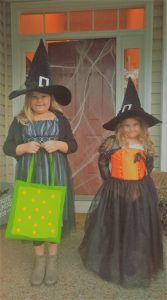
Happy Halloween!
by pmdavis | Oct 4, 2017
As part of National 4-H W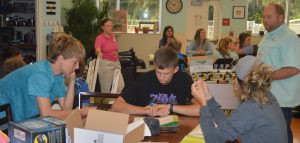 eek, 4-H’ers participate in 4 H National Youth Science Day (NYSD), the world’s largest youth-led science experiment. This year’s 4 H NYSD event will take place on October 4. The 2017 4‑H National Youth Science Day Challenge is called Incredible Wearables! This year’s challenge was developed by University of Nebraska-Lincoln and incorporates the fast-evolving field of wearable technology, teaching kids to not only use technology but to create it and understand how it works.
eek, 4-H’ers participate in 4 H National Youth Science Day (NYSD), the world’s largest youth-led science experiment. This year’s 4 H NYSD event will take place on October 4. The 2017 4‑H National Youth Science Day Challenge is called Incredible Wearables! This year’s challenge was developed by University of Nebraska-Lincoln and incorporates the fast-evolving field of wearable technology, teaching kids to not only use technology but to create it and understand how it works.
From watches and eyewear to fashion and virtual reality headsets, wearable technologies are fast becoming the must-have accessory for forward-thinking people around the world. Wearable technologies didn’t start out as trendy however – one of the world’s first wearable technologies was the hearing aid! Wearable technologies are now used in industries around the globe, from education and sports, to health, fashion, entertainment, transportation and communication. In this year’s challenge, youth use the engineering design process to build a prototype wearable technology that will gather data to help solve a real-world problem. They will design and build their own low-cost wearable health monitor following the engineering design process. This process includes defining the problem, designing and building prototypes (solutions) then systematically testing and evaluating enabling them to redesign for optimization of wearability and functionality.
During the innovative, hands-on project, these future engineers must work together to design, build and refine a wearable health-tracking device that is easy-to-use and aesthetically appealing. In fact, youth from Bay County have been training with their adult leaders to teach this challenge to other youth in their community on National Youth Science Day. Jason Scott, from Scott Innovative Solutions and an engineer at NSA PC, teamed up with the Bay County 4-H Agent to teach youth and adult partner teams about this project enabling them to be able to share their knowledge with others on October 4. When participants will attempt to solve the problem of people not staying active enough to lead healthy lives. In fact, youth will build a prototype fitness tracking device that could ultimately be marketed and sold to consumers to positively affect fitness behaviors.
After completing the challenge youth will have had an experience of using the engineering design process to build a device to help them monitor their health so they can gather data to make better decisions. They will understand more about how wearable technologies like FitBits, Smartwatches and other wearable devices are made.
The field of wearable technologies continues to grow in both quantity and quality. New technologies are being developed and put on the market on a regular basis, including virtual reality and augmented reality devices, clothing and accessories, as well as health monitoring devices. The future of wearable technologies is limited only by the imaginations of those designing them. By studying STEM and participating in this National Youth Science Day Experiment, youth could use technologies to develop products and mechanisms we haven’t even thought of, but definitely desire! To find out more information about other 4-H programs like this or volunteer your time to work with youth, contact your local UF IFAS County Extension Office or visit http://florida4h.org.
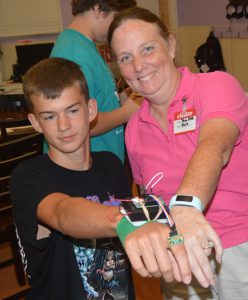
Comparing device to prototype
by Heather Kent | Jun 15, 2017
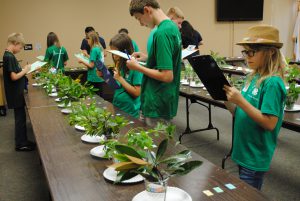
4-H Judging Contests, like horticulture identification, teach essential life skills for work and personal success.
Horticulture is one of our state’s leading industries, and for decades, the 4-H Horticulture ID contest has helped youth learn about this industry and demonstrate mastery of horticultural identification skills. Even if a youth does not pursue a career in the horticultural industry, learning the material for this contest can benefit them in other ways. To learn more about how judging teams teach workforce skills, check out this previous blogpost.
This year, the State 4-H Horticulture Judging Contest received an extreme makeover, to expand the program to even more youth. The state contest was held this past Saturday, June 10th at the Hillsborough County Extension Office in Tampa, FL (previously, the contest was held in Gainesville during 4-H University and was only open to 4-H seniors). For the first time ever, the contest is now open to youth between the ages of 8 and 18 (juniors, intermediates, and seniors). Study materials were adapted and revised to be age appropriate, and a webinar for coaches was offered. The webinar was archived and can still be viewed by anyone interest in coaching a team.
There are five parts to the contest:
- Woody Ornamentals identification
- Flowers and Foliage identification
- Fruits and Nut identification
- Vegetable identification
- Judging classes (youth look at a group of four fruits, plants, vegetables or nuts and rank them from best quality to poorest quality).
The contest is organized by a group of University of Florida Extension Specialists and volunteers. In addition to the resources online, youth can contact their local Master Gardener Program through their local UF IFAS County Extension Office for support. Many master gardener volunteers are willing to help teach plant identification, and may be willing to serve as a coach for your club. In fact, Master Gardeners can earn bonus points towards their state contest for helping 4-H clubs and teams prepare!
If this program interests you, sign up for 4-H! 4-H is open to youth ages 5-18. Adults can join 4-H as volunteers. Florida 4-H offers a variety of volunteer roles to fit your specific interests, skills and schedule. For more info, visit http://florida4h.org or contact your local UF IFAS County Extension Office.
Helpful Links:
by Niki Crawson | Apr 25, 2017
The month of April brings one of my favorite times of the year. We have the Easter Bunny showering us with treats on Easter and the Earth dancing on its axis for Earth Day. Pick any type of towering tree for Arbor Day and then there are a gazillion funny pranks and jokes to be told for April Fool’s Day. Add a week to highlight the wonderful generosity of volunteers giving in organizations around the world and you have one fabulous month of the year! That’s right! April dedicates a week each year, National Volunteer Appreciation Week, to recognizing and celebrating individuals that give of themselves to help others.

Kim Gilbert is a 4-H volunteer that values both the impacts she makes and receives from being involved in 4-H.
To help the month of April highlight our NW District’s large green family of fabulous 4-H volunteers, let me introduce you to one of my 4-H volunteers befitting of April, 4-H, volunteering, and bunnies, oh my! Meet Kim Gilbert, a Holmes County 4-H Volunteer, who has been the Rabbiteers Club Leader for the past two years. With two daughters in 4-H of her own, she is a true example of a 4-H parent, volunteer, and supporter. Kim fully supports the idea of 4-H being a big family and continually emphasizes this point in her 4-H club meetings. She believes in 4-H’s essential elements and strongly stresses belonging and generosity with her club members. As Kim explains, “You become a big family when you join 4-H and you can count on everyone to help out and pitch in. I love my 4-H family!”
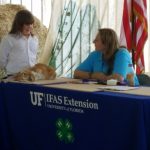
Chloe, learned to show her rabbit before a judge in a local 4-H fair.
Kim is always full of enthusiasm, encouragement, and new ideas that she shares with the youth and their rabbits. Armed with a soft rabbit in each arm and usually sweets for each club member too, Kim hops off to get her club meeting started. With a background in raising, breeding, and judging rabbits, Kim is knowledgeable in a variety of rabbit breeds including Holland Lops, English Lops, Polish, Lionheads, Angoras, and Giant Angoras. Not raised in 4-H as a child herself, she is thankful that she is able to provide 4-H opportunities to her own daughters and also give back by volunteering through leading the 4-H Rabbiteer Club. Since Kim’s involvement with the Rabbiteers, Holmes County 4-H youth have learned how to participate in showmanship in local rabbit shows and fairs. When not leading club meetings, Kim will often times volunteer to work on exhibits and events to help staff and other clubs.
When asked which of the 4 H’s best represented her, i.e. Head, Heart, Hands, or Health, Kim stated that was actually a very hard question. As a 4-H Agent who has worked closely with her for two years, I had no doubt which one represented her immediately but I patiently waited for her own reply with a secret smile on my face. After a moment, Kim replies, “I would say it is a tie between Hand and Heart but if I had to choose, I guess I will go with Heart.” Without a doubt, she nailed the answer perfectly! Kim is definitely one that is always thinking of others first, whether it is a simple note of well wishes or a thoughtful goodie bag of treats for each youth. She leads the youth and other adults with her heart and demonstrates the role of a 4-H club leader very well, truly encompassing the passion that was founded when 4-H adopted the motto “to make the Best Better.”
Kim is a true advocate of 4-H, firmly believing that not only does she positively impact youth as a 4-H volunteer but that she is being impacted by the organization as well.
According to Kim, “4-H has totally impacted my life in a way that I would not have seen two years ago. It has changed the way I look at things, how I handle things and has also taught me more things about my own self. 4-H has also brought my own family closer, learning to share more with each other.” Ah, there’s that generosity component we 4-Hers love to spread so much!

Hop on over to http://florida4h.org/volunteers_/ to join our 4-H family!
With truly caring volunteers in our 4-H family, it’s no wonder that 4-H is one of the nation’s largest youth development organizations in the world. If you are not a 4-H volunteer yet, what is stopping you? Hop on over to our website at http://florida4h.org/volunteers_/ to join our 4-H family as a volunteer! We have something for everyone!
by Melanie Taylor | Apr 24, 2017
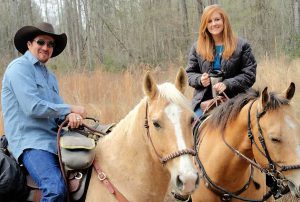
Russell and Julie McMillian, Gulf County 4-H Alumnae and 4-H Leaders
Russell and Julie McMillian both grew up in Gulf County and together have established a thriving business based on their love of horses. They now own a small farm in Dalkeith, just south of Wewahitchka, and their business Rockin’ M Ranch, consists of horseback riding lessons for beginners and beach rides for tourists and locals alike along the beautiful beaches of Cape San Blas.
How did this all begin? Russell and Julie both grew up as Gulf County 4-H members of the Big River Riders 4-H Club. They both participated in a variety of 4-H programs; including Horse Camp, Camp Timpoochee, Congress (now known as 4-H University), District Events, North Florida Fair Ag Judging, Area A and State 4-H Horse Shows, etc. They both learned the values of 4-H through learning how to raise and compete with their animals, agricultural commodities, leadership skills, public speaking, community service, good decision making skills, and much more…
As adults, they both went in separate directions, but still maintained their love of horses and the farm life. Russell began his career in flooring and tile work, while Julie received her education degree and taught Kindergarten at Wewahitchka Elementary School. After reconnecting as adults, they married on September 25, 2010 and turned their passion for horses into a full-time love by creating their own business, Rockin’ M Ranch. Russell still does flooring, tile work on the side, and helps his grandparents with their hay business. Julie decided to leave the teaching field, and she manages their business full time. She began giving beach rides on the Cape at the age of 14 and still loves it as much today.
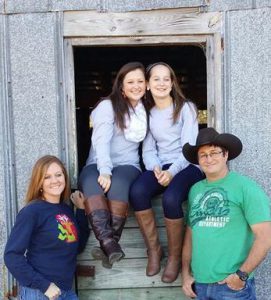
Julie and Russell McMillian pictured with Brooke (left) and Hayleigh (right).
Russell began his time with 4-H at the age of 12 and Julie was 8 years old. As members of the Big River Riders 4-H Club, they adored their 4-H leaders, Mr. Jesse Eubanks and Ms. Jean McMillian (Russell’s grandmother), and the Gulf County Extension Director, Roy L. Carter (now retired), whose passion for horses was contagious. Julie explained that she was a very shy child and that participating in public speaking for District Events really helped her come out of her shell. They both loved learning the values of the four H’s: Head, Heart, Hands, and Health. They feel 4-H has helped them develop into productive adults with good decision-making skills and in-stilled in them the importance of giving back to their community. They have served as 4-H volunteers for the Big River Rider’s 4-H Club since Russell’s daughters joined 4-H years ago; Brooke (17) and Hayleigh (15) also ride horses and have competed in a variety of Gulf County 4-H programs throughout the years. Russell and Julie have also taught a variety of horse riding classes at multiple Gulf County 4-H day camps.
As 4-H and community leaders, their most important goal is to give back to the community that gave to them as 4-Hers growing up here. They really love introducing new riders to the love of horses and 4-H. On any day, Russell and Julie can be found throughout the county at various events supporting 4-H members and any youth for that matter.
When asked what advice she has for someone thinking about becoming a 4-H volunteer she said, “Do not have regrets…just do it. Do not be scared off by the fingerprinting and application process. It is quick and easy, and maintains the safety for you and the children. Get started! 4-H is a great opportunity for youth and adults.”
“As a 4-H extension agent, you can only hope to find 4-H volunteers as dedicated as Russell and Julie McMillian. Their passion and love of 4-H is infectious and draws in youth looking for a place to belong.” -Melanie Taylor, Gulf County 4-H Agent
For more information about Rockin’ M Ranch, please go to http://www.therockinmranch.com/. For more information about how to become involved in 4-H, either as a youth member or adult volunteer, visit florida4h.org or contact your local UF IFAS County Extension Office. 4-H offers a variety of roles for volunteers to share their passions, skills and interests.
by Jenny Savely | Dec 19, 2015
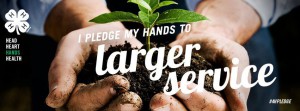
Clear evidence of mastering a skill is being able to employ it in one’s everyday life. Knowledge is only as good as how we are able to use it. 4-H dedicates itself to educating youth with research based curriculum not only for their own benefit but also so they can share that knowledge with others. When we “pledge our hands to larger service”, this can take on many forms. It may look like teaching youth in a community center about robotics or gardening, making meals for the military and first responders, or cleaning up trash in local parks. In all our service, it is important that regardless of what this looks like that we focus on meeting a need in our community. Identifying these needs is sometimes difficult if they are not part of what we see around us regularly. Talking to people who do not have the same life experiences we do is a good way to start seeing the world in a different way and thinking about ways you can help others who haven’t had the same opportunities. In Escambia County, around 30% of our youth population lives in poverty (US Census). Outcomes of living in poverty are hunger, poor housing, poor health, and lower educational scores, just to name a few. Our 4-Hers are learning to use the skills they have gained in 4-H in creative ways to help address some of these issues. One club has received a grant to raise a hog that a youth will show and have processed so the meat can be included in food boxes for local families. Another club raised funds to help support the Council on Aging to provide air conditioning units to the elderly, who are more likely to be impoverished, during the hot summer months.
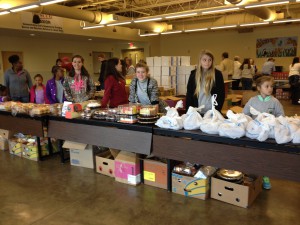
Escambia County 4-Hers assemble food boxes for local families at this year’s Farm to City event.
Whether poverty, pollution, safety, education, healthcare, or another issue is one that effects your community, the skills youth learn through 4-H can help address it. Not only does this help those around us live healthier and more productive lives, but it helps those who serve connect to their community and learn to give back. As with all 4-H projects, our goal is to help youth become more engaged and knowledgeable citizens that contribute to their world in positive ways. We encourage our youth to embody the spirit of generosity all year long, but during this season, be sure to explore the needs in your community you can help to change, even in the smallest way. If you need help thinking of how to best give back, contact your local 4-H Agent, local non-profits, or look up your county’s information in a database such as the US Census’ QuickFacts (http://quickfacts.census.gov/qfd/states/12000.html) and think about what kinds of problems might arise from the information you find there.
4-H also offers many Leadership and Citizenship projects that can help youth navigate assessing the needs of their community and putting their skills to use. You can find a few such project guides at the following links:
If you are interested in helping guide the next generation to be compassionate, active citizens for tomorrow, consider becoming a 4-H Volunteer. 4-H offers a wide variety of roles to fit your interests and schedule. Visit http://florida4h.org or contact your local UF IFAS Extension Office.
US Census. 2015. American Community Survey 2009-2013 five-year estimates, Children Characteristics: Escambia County, FL. Accessed November 18, 2015.











